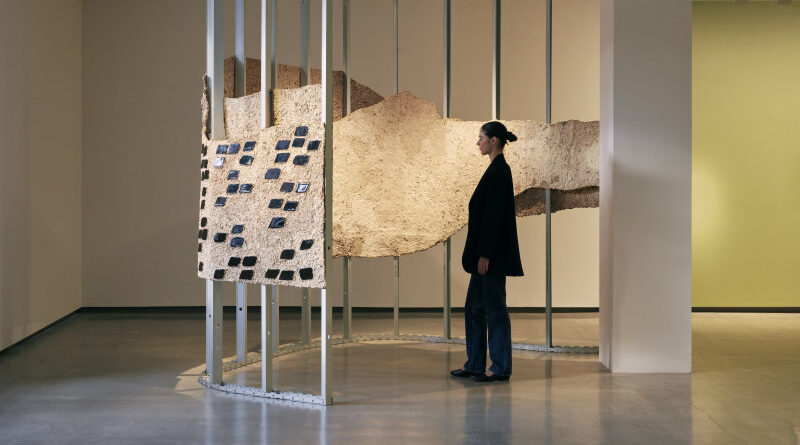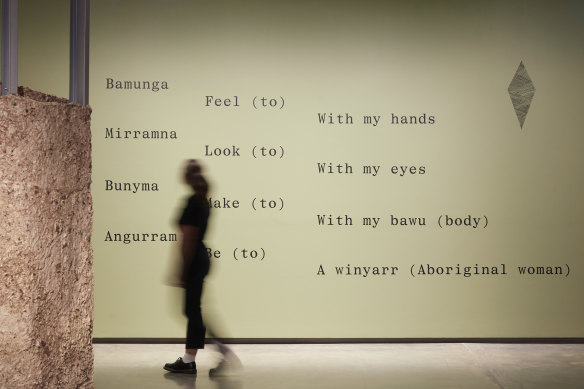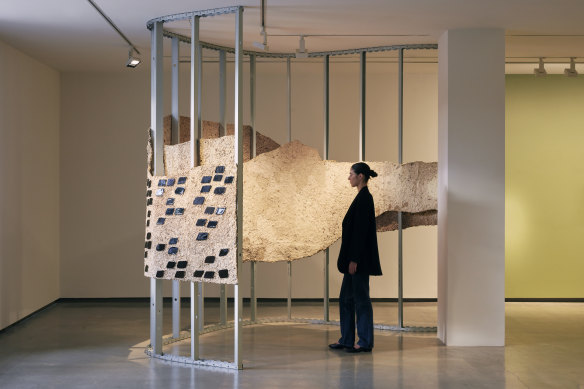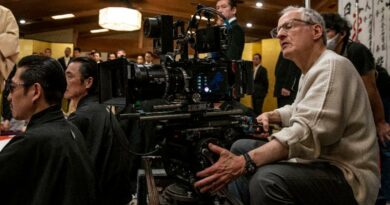The talented and the restless: Six young artists to watch at Primavera
Save articles for later
Add articles to your saved list and come back to them any time.
Nothing is ever certain in the notoriously fickle world of contemporary art, however, the list of names chosen to exhibit at Primavera, the Museum of Contemporary Art’s annual exhibition of work for artists under 35, is as good an indicator of future stars as any.
Take Sydney-based Julia Gutman, who, less than 12 months after her work was shown at last year’s Primavera, became a household name when she won the 2023 Archibald Prize with Head in the sky, feet on the ground.
Moorina Bonini’s, dapalama (between), 2023. “It’s a way of really being quite critical of the space itself”. Credit: Zan Wimberley
Other Primavera alumni who have gone on to achieve national and international prominence include Mikala Dwyer (1992), Nell (1999), Jonathan Jones (2003), Soda Jerk (2008), Paul Yore (2014), Hoda Afshar (2019) and Marco Fusinato (1998), who last year represented Australia at the Venice Biennale.
This year’s crop of young talent features work by Moorina Bonini, Christopher Bassi, Tiyan Baker, Nikki Lam, Sarah Poulgrain and Truc Truong, guest curated by Granville Centre Art Gallery’s Talia Smith.
Smith says Primavera has a restless energy that distinguishes it from the MCA’s usual offerings of international solo exhibitions and summer blockbusters.
“When I was invited to curate Primavera, that’s how I saw it fitting into – or not fitting in, really – to the structure of the gallery,” she says.
Smith has been thinking about how systems such as colonialism, religion, law and housing continue to fail many people, especially since the pandemic.
“I wanted to create a show that brought together people that are looking at alternative ways or even collectivising in a way to create or reimagine what these structures could look like. How to live, basically, in among all the chaos.”
However, Smith acknowledges this isn’t a new thing.
“Artists have been protesting and persevering and reimagining for so long,” she says.
Yorta Yorta, Wurundjeri, Wiradjuri and Italian artist Bonini is deeply familiar with protest.
Sarah Poulgrain with Learning how to build a houseboat: walls, fixings and rope, 2023.Credit: Zan Wimberley
“I come from a really strong, matrilineal line of incredibly staunch Aboriginal women that have a long history in protest and resistance in Victoria,” she says.
Bonini makes works about the intersection of Western ideas of art and Indigenous knowledge systems.
Her work for Primavera, In dapalama (between) (2023), is a series of texts and charcoal marks across the gallery space.
“In an Aboriginal context, we use our marks to identify,” she says. “We marked our shields and coolamons and those marks are usually indicative of places of country and of stories.
“These excerpts of my ‘mulana’ writing – mulana means ‘spirit’ in Yorta Yorta – I see them as a place mark or a mark itself,” she says. “The way that I’ve reinstated or reinscribed these marks through my writing, it’s a way of really being quite critical of the space itself, interrogating and acknowledging the tension that exists between myself and my bawu [body] and the Western institutions in which I exist and work.
“It’s an interrogation of the structure, but it’s also an interrogation of each and everyone’s own position within the institution, thinking about our own values, our own privileges, our own cultural understandings of what this means. It’s a quiet work but it involves everybody. It comes from me, but everyone’s implicated in this conversation.”
Meanwhile, Brisbane-based artist Sarah Poulgrain is particularly interested in ideas of self-sustainability.
“My practice aims to facilitate a model of knowledge-sharing that disrupts power dynamics and prioritises vulnerability and trust,” she says.
What this means practically is learning new skills – everything from aluminium casting to welding and hat-making – and then teaching those skills to others.
“I find making functional things for myself helps with feeling powerful and in control of my life,” she says. “Though I produce sculptures, my practice is primarily concerned with building and sustaining respectful and non-hierarchical relationships.”
Her work for Primavera, Learning how to build a houseboat: walls, fixing and rope (2023), was made in collaboration with fellow Brisbane artists and came out of newfound skills developed through building a pontoon houseboat that will operate as a collective art space and living space.
While she has made several iterations of her series A set of new skills , the recent floods and climate crises, as well as the cost of living and housing crises, have brought a fresh urgency to this latest project.
“The aim of the project is to create a climate and gentrification-resilient ARI [artist-run initiative] for Meanjin [Brisbane] experimental art, untying the contingency of art spaces on real estate rental markets,” she says.
“Sydney Harbour and the MCA is a very wealthy and culturally prestigious location, it’s definitely the fanciest place I have exhibited … While the framework of Primavera certainly gives cultural activity an aura of authority and sophistication, I hope it can also be a framework that allows the work to be accessible and un-intimidating.”
Other rising stars at Primavera
-
Christopher Bassi uses European painting techniques to tell stories of his Torres Strait
Islander heritage and history. His series of works, Monuments to the South/West Waters of a Great Ocean (2023), elevates the humble shell to comment on the legacies of colonialism and the role of fishing and pearling in the Arafura Sea. - Malaysian Bidayûh-Anglo Australian artist Tiyan Baker’s Personal computer: ramin ntaangan (2022- 2023) features a miniature, traditional Bidayûh longhouse that holds a self-assembled computer showing images of Baker’s ancestral home. Digital platforms are one of the central means for her to collect and remain connected to her culture.
- Artist-curator Nikki Lam’s film The unshakeable destiny_2101 (2023) is the first in a trilogy of films that draws on the history of Hong Kong cinema and hidden visual languages of protest to explore the experience of activism and identity from overseas.
- Truc Truong’s I Pray You Eat Cake (2023) is a sprawling installation of found objects spilling from a lazy Susan table. With visual references to everything from yum cha to Buddhist temple offerings and childhood games, Truong explores the complexities of her migrant upbringing and her parents’ experiences of a Vietnam that no longer exists.
Most Viewed in Culture
From our partners
Source: Read Full Article





